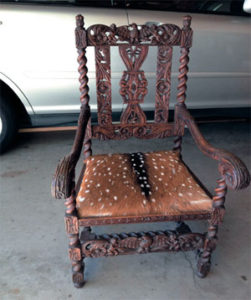 I hear this question a lot: “Do you think we’ll sell this piece of furniture here in Santa Barbara?” Generally I answer, if it’s not Renaissance Revival, and moreover, if it’s not Spanish Colonial Revival, maybe NOT. When I say Spanish Colonial Revival, you all know what I mean. The Santa Barbara architectural style, with a complementary furniture style (think our courthouse). So when Anna Rae sent me a photo of her Renaissance Revival arm chair, with a deerskin seat, no less, I thought, now is the time to tell you about an important period of furniture, which means dollars here in Santa Barbara.
I hear this question a lot: “Do you think we’ll sell this piece of furniture here in Santa Barbara?” Generally I answer, if it’s not Renaissance Revival, and moreover, if it’s not Spanish Colonial Revival, maybe NOT. When I say Spanish Colonial Revival, you all know what I mean. The Santa Barbara architectural style, with a complementary furniture style (think our courthouse). So when Anna Rae sent me a photo of her Renaissance Revival arm chair, with a deerskin seat, no less, I thought, now is the time to tell you about an important period of furniture, which means dollars here in Santa Barbara.
In the history of design, only one period ONLY reached back to the past, the last quarter of the 19th century, for its NEW styles.
A partial list of periods that saw revival:
- Egyptian
- Gothic
- Italian/Spanish
- French
- Pilgrim
- Chinese
Many questions I get about this style of throwbacks refer to authenticity. Did this chair come from the late 19th century (Victorian period)? Or is it as old as it looks? In other words, from the 17th century? This style didn’t completely copy the 17th-century styles, but added the typical Victorian flourish to them, meaning more flourishes and a bigger scale. Thus the revival furniture that seems ancient was designed with the intent to appear more “authentic” than the actual historical period. Think of Hollywood recreations of certain historical periods, which involves overkill.
What late 19th century designers of furniture tried to do
Nostalgia for the old days associated with castles, palaces and great houses, England and then the U.S. entered the age of the sweat factory and machine. Think of the Pugin and Barry designed Houses of Parliament in Westminster. Not finished until 1870, they featured the “national” English style, Gothic. Wait, Gothic? England style saw Gothic from 1180 till 1500, not 1870. But a look back architecturally showed the great old times still lived.
Another style popularly revived in this time, the Jacobean, transplanted through the Mayflower, began the history of furniture making in America. This included furniture made of oak, angular and rudimentary, although robustly carved.
17th Century Reflected in Furniture
Ms. Rae’s chair reflects that period of the 17th century with furniture made of oak, ornate and baronial in style. Our distinct love of the revival style here in Santa Barbara hearkens back to the 17th century, by which time various nations assimilated the style of Renaissance Italy. This style heralded the flourishes of the rediscovered Classical Age of Greece and Rome, and traveled with new flavors to Spain and then to Santa Barbara. This style became the rage in the last quarter of the 19th century, the age of revivals. All the best houses in the Spanish Colonial style here in Santa Barbara have some furniture from this period, because of it appropriateness to our signature architecture.
Recently I visited such a house and my client asked if her 17th-century-looking chair really was 17th-century, just like Ms. Rae. The answer is that it’s too authentically perfect to be 17th-century, too much what we think of as a regal Spanish Renaissance chair, and of course in the larger scale we associate with a larger 19th-century gent. So, Ms. Rae, your chair is late 19th-century, and a beautiful example of the Renaissance Revival style, and in Santa Barbara is worth $1,200. In other parts of the U.S., say, for example, the rural Illinois town I grew up in, it’s not worth that much. A place where you NEVER see white stucco and red tile roofs will never understand Spanish Colonial furniture. I grew up with revival furniture called Early American (remember that). We loved Ethan Allen in Illinois.
History according to Elizabeth Stewart gets woven in so interestingly. You never disappoint and I learn with every column.